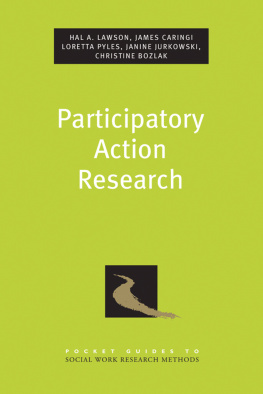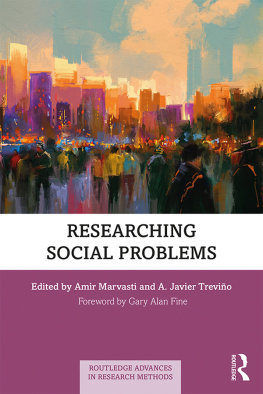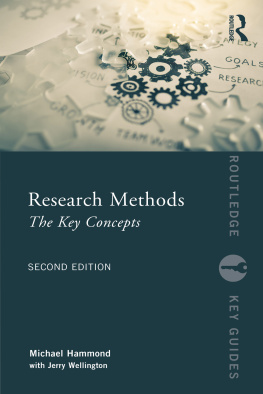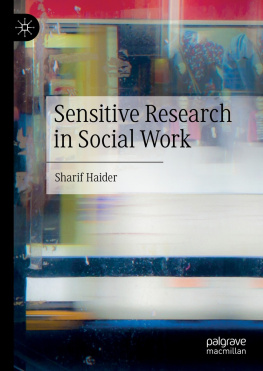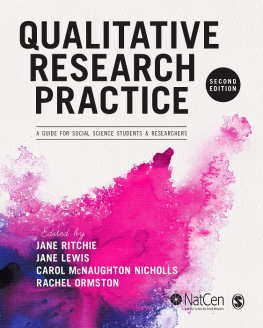Participatory Action Research
POCKET GUIDES TO
SOCIAL WORK RESEARCH METHODS
Series Editor
Tony Tripodi, DSW
Professor Emeritus, Ohio State University
Determining Sample Size
Balancing Power, Precision, and Practicality
Patrick Dattalo
Preparing Research Articles
Bruce A. Thyer
Systematic Reviews and Meta-Analysis
Julia H. Littell, Jacqueline Corcoran, and Vijayan Pillai
Historical Research
Elizabeth Ann Danto
Confirmatory Factor Analysis
Donna Harrington
Randomized Controlled Trials
Design and Implementation for Community-Based Psychosocial Interventions
Phyllis Solomon, Mary M. Cavanaugh, and Jeffrey Draine
Needs Assessment
David Royse, Michele Staton-Tindall, Karen Badger, and J. Matthew Webster
Multiple Regression with Discrete Dependent Variables
John G. Orme and Terri Combs-Orme
Developing Cross-Cultural Measurement
Thanh V. Tran
Intervention Research
Developing Social Programs
Mark W. Fraser, Jack M. Richman, Maeda J. Galinsky, and Steven H. Day
Developing and Validating Rapid Assessment Instruments
Neil Abell, David W. Springer, and Akihito Kamata
Clinical Data-Mining
Integrating Practice and Research
Irwin Epstein
Strategies to Approximate Random Sampling and Assignment
Patrick Dattalo
Analyzing Single System Design Data
William R. Nugent
Survival Analysis
Shenyang Guo
The Dissertation
From Beginning to End
Peter Lyons and Howard J. Doueck
Cross-Cultural Research
Jorge Delva, Paula Allen-Meares, and Sandra L. Momper
Secondary Data Analysis
Thomas P. Vartanian
Narrative Inquiry
Kathleen Wells
Structural Equation Modeling
Natasha K. Bowen and Shenyang Guo
Finding and Evaluating Evidence
Systematic Reviews and Evidence-Based Practice
Denise E. Bronson and Tamara S. Davis
Policy Creation and Evaluation
Understanding Welfare Reform in the United States
Richard Hoefer
Grounded Theory
Julianne S. Oktay
Systematic Synthesis of Qualitative Research
Michael Saini and Aron Shlonsky
Quasi-Experimental Research Designs
Bruce A. Thyer
Conducting Research in Juvenile and Criminal Justice Settings
Michael G. Vaughn, Carrie Pettus-Davis, and Jeffrey J. Shook
Qualitative Methods for Practice Research
Jeffrey Longhofer, Jerry Floersch, and Janet Hoy
Analysis of Multiple Dependent Variables
Patrick Dattalo
Culturally Competent Research
Using Ethnography as a Meta-Framework
Mo Yee Lee and Amy Zaharlick
Using Complexity Theory for Research and Program Evaluation
Michael Wolf-Branigin
Basic Statistics in Multivariate Analysis
Karen A. Randolph and Laura L. Myers
Research with Diverse Groups:
Diversity and Research-Design and Measurement Equivalence
Antoinette Y. Farmer and G. Lawrence Farmer
Conducting Substance Use Research
Audrey L. Begun and Thomas K. Gregoire
A Social Justice
Approach to Survey Design and Analysis
Llewellyn J. Cornelius and Donna Harrington
Participatory Action Research
Hal A. Lawson, James Caringi, Loretta Pyles, Janine Jurkowski, and Christine Bolzak

Oxford University Press is a department of the University of Oxford. It furthers the Universitys objective of excellence in research, scholarship, and education by publishing worldwide.
Oxford New York
AucklandCape TownDar es SalaamHong KongKarachi
Kuala LumpurMadridMelbourneMexico CityNairobi
New DelhiShanghaiTaipeiToronto
With offices in
ArgentinaAustriaBrazilChileCzech RepublicFranceGreece
GuatemalaHungaryItalyJapanPolandPortugalSingapore
South KoreaSwitzerlandThailandTurkeyUkraineVietnam
Oxford is a registered trademark of Oxford University Press in the UK and certain other countries.
Published in the United States of America by
Oxford University Press
198 Madison Avenue, New York, NY 10016
Oxford University Press 2015
All rights reserved. No part of this publication may be reproduced, stored in a retrieval system, or transmitted, in any form or by any means, without the prior permission in writing of Oxford University Press, or as expressly permitted by law, by license, or under terms agreed with the appropriate reproduction rights organization. Inquiries concerning reproduction outside the scope of the above should be sent to the Rights Department, Oxford University Press, at the address above.
You must not circulate this work in any other form and you must impose this same condition on any acquirer.
A copy of this books Catalog-in-Publication Data is on file with the Library of Congress
ISBN 9780190204389
ISBN 9780190204402
Contents
Hal A. Lawson
Hal A. Lawson
Hal A. Lawson and James C. Caringi
Christine T. Bozlak and Michele A. Kelley
Janine M. Jurkowski, Kirsten Davison, and Hal A. Lawson
Loretta Pyles and Juliana Svistova
Hal A. Lawson, Christine T. Bozlak, James C. Caringi, Loretta Pyles, and Janine M. Jurkowski
We appreciate the guidance and support provided by Toni Tripodi, the series editor, and Agnes Bannigan, our consulting editor. We also were guided by three external reviewers who provided insightful criticism and important suggestions.
We also appreciate two graduate students contributions. The University at Albanys Joe Chiarenzelli provided research assistance related to institutional review boards. The University of Montanas Jean Ali Church did the lions share of the work on organizing the references.
A variety of funding agencies supported our work, and we remain grateful to their respective program officers. For example, the work on design teams (see ) was supported by the National Science Foundation (Grant 1133264 of the Disaster Resilience in Rural Communities Program).
Above all, we are grateful to the countless people we have worked with and learned from in our respective participatory action research initiatives. This book would not have been possible without their participation, teaching and guidance, contingent feedback, patience and tolerance, engagement, expertise, and service as co-researchers.
Hal A. Lawson
Participatory action research (PAR) is a special investigative methodology. It connects and integrates five priorities. First, PAR enables democratic participation in real-world problem-solving by local stakeholders who typically lack formal research training and credentials when the research begins. Second, this democratic participation occurs in successive action research cycles, which can be described simply as plan, do, study, and act. Third, new knowledge and understanding are generated as local problem-solving proceeds, thus qualifying PAR as research (e.g., ). Fourth, this practice-generated knowledge responds to practitioners and policymakers knowledge needs because relevant, useful knowledge for policy and practice is derived from them.

